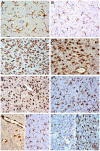Microglia immunophenotyping in gliomas
- PMID: 29399160
- PMCID: PMC5772881
- DOI: 10.3892/ol.2017.7386
Microglia immunophenotyping in gliomas
Abstract
Microglia, once assimilated to peripheral macrophages, in gliomas has long been discussed and currently it is hypothesized to play a pro-tumor role in tumor progression. Uncertain between M1 and M2 polarization, it exchanges signals with glioma cells to create an immunosuppressive microenvironment and stimulates cell proliferation and migration. Four antibodies are currently used for microglia/macrophage identification in tissues that exhibit different cell forms and cell localization. The aim of the present work was to describe the distribution of the different cell forms and to deduce their significance on the basis of what is known on their function from the literature. Normal resting microglia, reactive microglia, intermediate and bumpy forms and macrophage-like cells can be distinguished by Iba1, CD68, CD16 and CD163 and further categorized by CD11b, CD45, c-MAF and CD98. The number of microglia/macrophages strongly increased from normal cortex and white matter to infiltrating and solid tumors. The ramified microglia accumulated in infiltration areas of both high- and low-grade gliomas, when hypertrophy and hyperplasia occur. In solid tumors, intermediate and bumpy forms prevailed and there is a large increase of macrophage-like cells in glioblastoma. The total number of microglia cells did not vary among the three grades of malignancy, but macrophage-like cells definitely prevailed in high-grade gliomas and frequently expressed CD45 and c-MAF. CD98+ cells were present. Microglia favors tumor progression, but many aspects suggest that the phagocytosing function is maintained. CD98+ cells can be the product of fusion, but also of phagocytosis. Microglia correlated with poorer survival in glioblastoma, when considering CD163+ cells, whereas it did not change prognosis in isocitrate dehydrogenase-mutant low grade gliomas.
Keywords: gliomas; immunosuppression; macrophages; microglia; phagocytosis.
Figures





References
-
- Simmons GW, Pong WW, Emnett RJ, White CR, Gianino SM, Rodriguez FJ, Gutmann DH. Neurofibromatosis-1 heterozygosity increases microglia in a spatially-and temporally-restricted pattern relevant to mouse optic glioma formation and growth. J Neuropathol Exp Neurol. 2011;70:51–62. doi: 10.1097/NEN.0b013e3182032d37. - DOI - PMC - PubMed
-
- Klein R, Roggendorf W. Increased microglia proliferation separates pilocytic astrocytomas from diffuse astrocytomas: A double labeling study. Acta Neuropathol. 2001;101:245–248. - PubMed
LinkOut - more resources
Full Text Sources
Other Literature Sources
Research Materials
Miscellaneous
